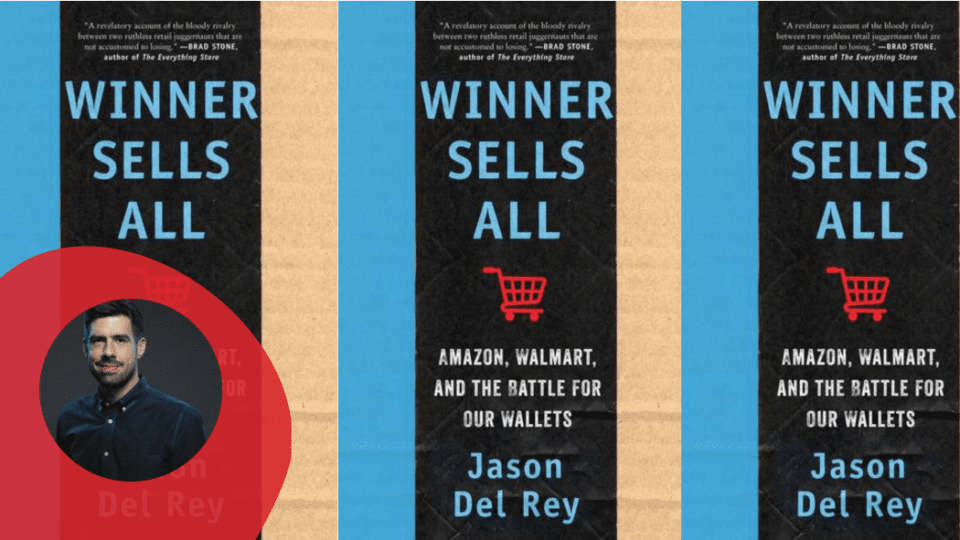Jason Del Rey is a veteran business journalist who spent a decade at Recode reporting on Amazon, Walmart and how technology is transforming retail. He even brought his findings to the airwaves (so to speak) as host of the podcast, Land of the Giants: The Rise of Amazon.
Now he is digging into the evolution of both Amazon and Walmart, and the ongoing battle between the two companies to reign in the commerce realm. His book, Winner Sells All, points to 2016 as the unofficial kickoff of this rivalry, when legacy retailer Walmart started moving into ecommerce and Amazon started investing in physical retail. Through in-depth reporting and interviews with employees and executives, the book offers an inside look at the companies’ “bare-knuckle power struggle.”
In a special interview with Retail TouchPoints, Del Rey expands on the key themes from the books, his takeaways and most of all, what other retail players can take from this head-to-head battle of omnichannel players.
Retail TouchPoints (RTP): You have spent a significant portion of your career covering both Amazon and Walmart. What were your biggest goals going into writing the book, and how did your approach evolve as you embarked on the writing process?
Jason Del Rey: I had a couple of main goals. One was to explain, hopefully in compelling fashion, how the actions of each of these companies influence the other, and thus impact the millions of consumers, employees and suppliers who buy from, work for, or do business with these giants. The other goal was to chronicle one of the greatest cases of the innovator’s dilemma in modern business history: Walmart’s decades-long struggle to adapt to ecommerce while telling the deepest tale of what has transpired inside the largest retailer in the world since The Walmart Effect was published more than 15 years ago.
RTP: Amazon has historically been lauded for its relentless approach to innovation; there have even been several books written about it. Has Amazon been able to maintain this cycle of ideation, execution and improvement? What challenges, either internal or external, are impacting the organization today?
Advertisement
Del Rey: If you talk to a ton of current and former Amazonians like I did for this book, and still do today, the short answer is “no.” There are exceptions, of course. I think there’s a lot of rapid improvement going on in areas like their advertising and logistics businesses, but they’ve also experienced some major challenges in recent years. I think one cause is simply the size of their organization. Even they aren’t immune from the bureaucracy that “bigness” sometimes creates. I think they also lost some discipline in recent years when it came to internal investments and how they would differentiate themselves when entering new sectors.
RTP: Can you expand upon the internal issues impacting Walmart’s ability to keep pace with Amazon’s approach to innovation? Has Walmart been able to speed up or improve its approach, especially with the creation of its Store No. 8 division?
Del Rey: The Marc Lore era at Walmart, if nothing else, brought a new sense of urgency to Walmart when it comes to new online features and services, and the incubation of new business ideas. Many didn’t work out, but Walmart’s innovation metabolism improved. That said, the company still has a lot of work to do in its digital transformation. In my sit-down with CEO Doug McMillon in 2022, he admitted that he is still dissatisfied with the speed of change at the company.
RTP: Despite being such a key disruptor in the retail industry, Amazon has struggled with its brick-and-mortar efforts. Can you pinpoint a few key reasons why, and also what this will mean for the company’s future investments in stores?
Del Rey: I think one of the top reasons is that they seem to have believed that technology could be the main in-store differentiator for them in physical retail, but they neglected some core retail tenets that matter most to many in-store shoppers. High in-stock rates matter; fresh produce in grocery stores matters; merchandising matters. I think we are seeing with some of their reworked Amazon Fresh stores in the Chicago area that they are getting back to the basics.
RTP: The retail industry has been facing its fair share of workforce challenges. How would you say both Amazon and Walmart are faring in the race for winning and retaining top talent?
Del Rey: If we’re talking about office jobs, I believe both companies are still attracting above-average corporate talent, and Walmart is attracting high-level digital talent that it couldn’t a decade ago. That said, each is also facing challenges. Amazon’s largest corporate layoffs in its history over the last year, plus heavy cost-cutting and a return-to-office mandate, has led to poor morale in many divisions of the company. At Walmart, while the unification of store and digital teams over the last couple of years was necessary, the insistence that many roles have to be based in Bentonville — even with a beautiful new corporate campus — is still a limiting factor in attracting the best talent possible.
RTP: You call out healthcare as a big battleground for Amazon and Walmart. How will the convergence of retail and healthcare impact the world of commerce more broadly?
Del Rey: As more facets of the healthcare and medical care space become digitally enabled, consumers will begin to expect even more services to be available at their fingertips across sectors. Meeting customers where they want, how they want and when they want will be paramount.
RTP: Both Amazon and Walmart have focused on building out their services and solutions for small and mid-size businesses. What do you believe this says about the future growth priorities of both Amazon and Walmart?
Del Rey: I think these focus areas are mainly about increasing profit margins to help offset pricing battles in their core retail/1P businesses. It is amazing that small and mid-size merchants can build sizable businesses without ever touching a piece of merchandise, thanks to services like Fulfillment by Amazon and Walmart Fulfillment Services, but it is still a risky proposition with product/account suspensions and bans still occurring with little warning.
Small and mid-size merchants want more choice, and [they] have been hoping for many years for Walmart to finally become a real alternative to only selling on Amazon and through their own DTC sites. Walmart is saying all the right things about their focus on their marketplace, but the next year or two should tell us more about how much of an alternative they are really becoming.
RTP: If you could identify one “legacy-defining bet” both Walmart and Amazon have made, what would they be?
Del Rey: I do believe the Jet.com acquisition was key to the omnichannel success that Walmart is experiencing today, at least in an indirect way. For all the Jet.com regime’s failures when it came to new features or business ideas, Walmart’s digital metabolism improved greatly in the years following the deal. The old narrative of Walmart being a digital laggard was mostly discarded, which helped recruiting and improved the lens in which investors viewed the company. I believe the pandemic also forced Walmart’s hand in a big way when it came to the company’s willingness to tie together their store and ecommerce operations in a very real way.
At Amazon, it’s hard to pick just one. The creation of the Marketplace decades ago, the buildout of FBA and the invention of Amazon Web Services are all key reasons why Amazon has grown into what it is today.
RTP: What are Amazon and Walmart’s biggest competitive differentiators today?
Del Rey: Amazon leaders worried for decades that Walmart would someday utilize its massive store network as an advantage in ecommerce to quickly fulfill both pickup and delivery orders. It took way too long, but Walmart is finally starting to do so in a real way.
And while the pace of invention at Amazon isn’t what it once was, the company still has the ability to introduce new business ideas and services into the market faster than many retailers.
















